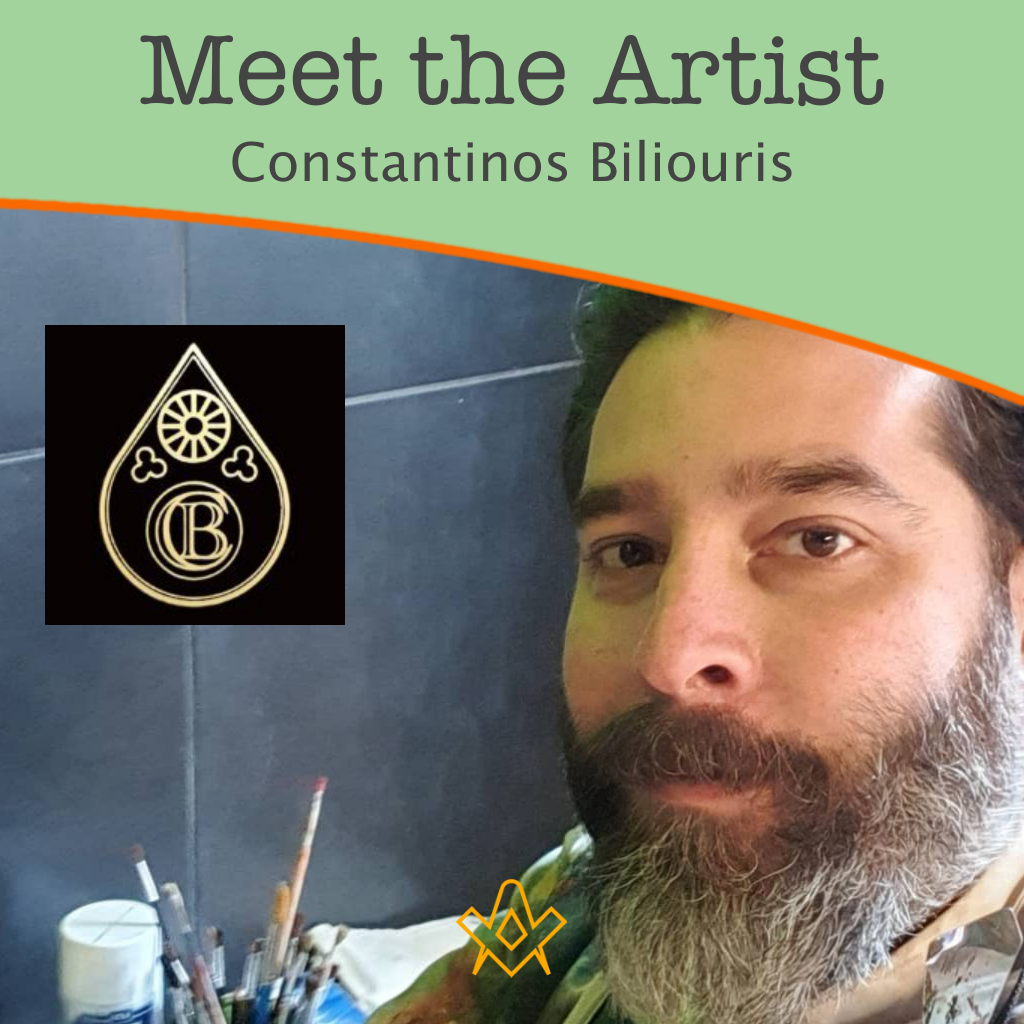Constantinos Biliouris is a Greek Artist and brother from the Grand Lodge of Greece who creates a range of hand painted masonic aprons.
Constantinos was born in Nea Ionia, Magnisia, in 1982. He has lived in Karditsa since 2010.
He studied Fine Art at the Florence Academy of Fine Art, graduating in 2004 with a specialisation in Artistic Anatomy.
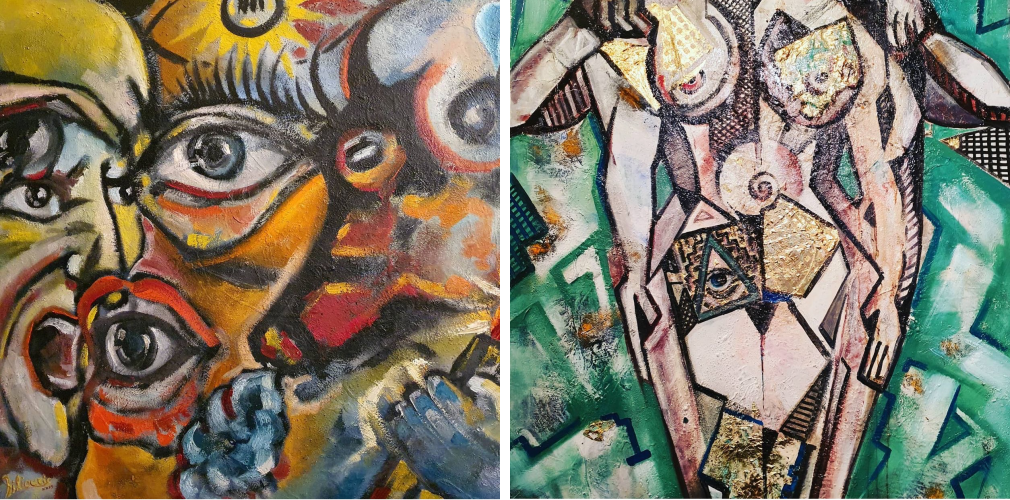
Images (c) copyright Constantinos Biliouris
He has presented 5 solo exhibitions and has participated in a number of group shows, two of which were hosted at the historic cafe of Futurist artists, ‘Giubbe Rosse’, in Florence.
His last solo exhibition was entitled ‘La Divina Commedia’.
Reference to Dante, an illustrative attempt (“Ionos” Gallery, Karditsa 2016).
In 2017 he participated in a group exhibition of artists from Thessaly, Greece, on the theme of the “Republic” by Agenagoras Asteriadis (Municipal Gallery of Larisa).
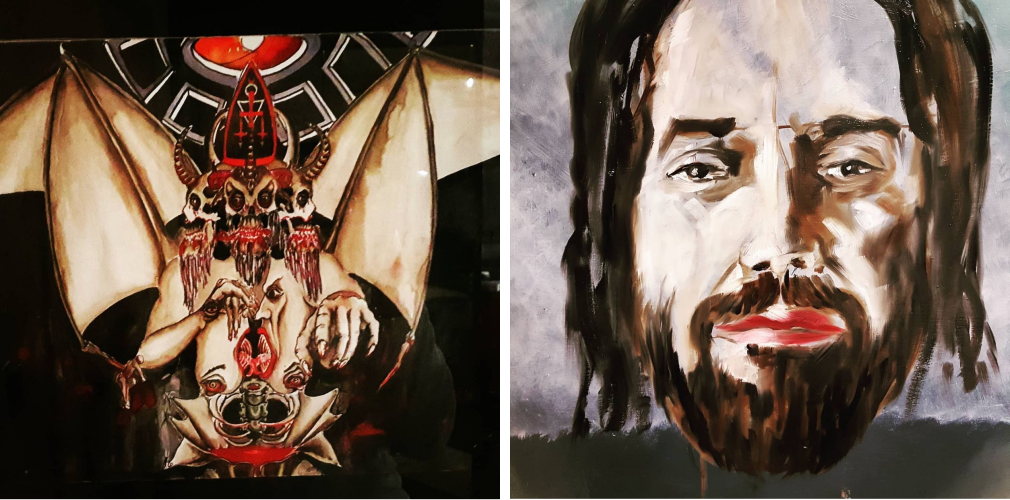
Images (c) copyright Constantinos Biliouris
In 2013 he founded the association “Action for Cultural Documentation in Education and Art – GRANA-ZEI Artech,” based in Karditsa, under which he organises annual seminars, drawing and fine art, comics, and animation seminars.
GRANA-ZEI’s visual art team participated with an installation in an exhibition entitled “LOVELETTERS TO CHAOS” (mettamatic:taf Art space, Athens 2003).
Constantinos has studied the theory of medieval and Renaissance art, analysing symbols and their usage by the great artists of these periods (Archaeological Museum of Karditsa 2016, Diachronic Museum of Larisa, 2019).
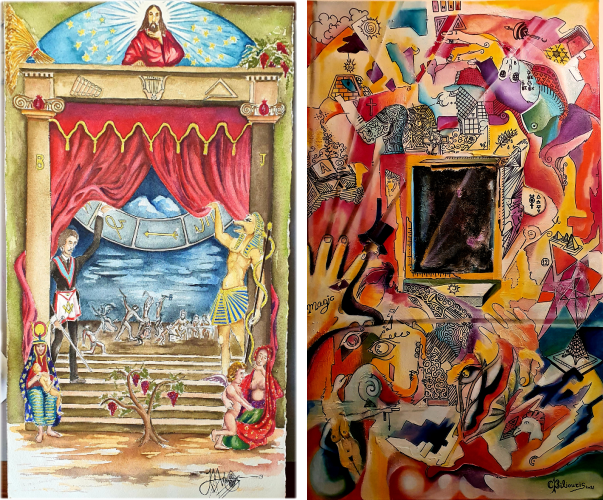
Images (c) copyright Constantinos Biliouris
Since 2021 he has been studying Philosophy at the University of Ioannina.
His interests include semiotics, symbols, and esoteric and mystical traditions. His paintings are allegorical and his art is infused with elements of metaphysics, alchemy, and the surrealist movement.
Since 2020 he has begun creating a number of ritual items, such as handmade Masonic aprons and other relevant works of art.
Hand Crafted Masonic Aprons
Constantinos has hand crafted a selection of painted masonic aprons, which are sold through his web site to Freemasons around the globe.
All these masonic aprons are one off peices and are fast becoming very collectable.


Images (c) copyright Constantinos Biliouris
Interview
Some things are pre-destined for each one of us, as if a superior power has provided for them. This is what I feel that has happened regarding art and freemasonry. They must have been destined for me, long before I was born. My choosing their direction was just the natural flow of the plan of the Immovable Mover.
Philippa Lee: Constantinos, thank you so much for answering my questions – we were delighted to discover your artwork and share it with our readers. It inspired us to want to know more about your influences, achievements and future plans and projects. Perhaps you could tell us about your background and how you came to study art?
Constantinos Biliouris: Firstly, I feel the need to deeply thank you for the opportunity to discuss my work, through your remarkable magazine.
I would characterize my work as decent and diligent effort. If somebody tried to peek out at my inner world, they would see darkness and they would find themselves into an uncharted maze, although an insider one.
My truth lies in the fact that I safely keep the burning heart of the creator into the room of my mysteries.
I have always remembered myself observing everything around me; however, despite my excellent visual memory I had been looking for ways to stop time and imprint on me the moments, the movements, the colours and the attitudes.
Since my early childhood I began hearing the loud inner voices, each one of which led me to a different form of nature depiction.
It was the period of experimentation with various materials, such as soil, glues, water, clay, wood.
My solitary character, though, in combination with the different way of perceiving reality, led me to lack peer communication.
My parents’ guidance was to be kind and avoid reacting towards the sacrilegious attitude of others to stay composed.
Since an early age, this mentality led me to focus on people’s mental quality instead of their external materialistic one.
I began to build a social circle of mainly quality souls rather than just children, friends, or teachers.
Through this spectrum I observed the movements, attitudes, expressions of the people around me and gradually I adopted a special filter in order to feel what is invisible to the others.
Nature got enlarged in front of my childhood eyes. Even since the last classes of primary school I was able to easily imprint on my mind an invisible world with pictures which had my own unique meaning.
My childhood mind, even though I don’t actually believe in the distinction between childhood mind and adulthood one, created relations among meanings, which were my own symbols.
This is how I started experiencing my magical world of symbols. I preferred the companionship of the elderly in my neighbourhood instead of the younger ones.
I carefully listened to whatever they willingly narrated from their life experience. Their pictures started increasing inside me.
The only peer with whom I could communicate was Panos, a cousin of mine, slightly older than me; he was a kid with vivid imagination and incredible dexterity, which is why now he is a machinist.
He was the narrator of scary stories. Back then, there was a neighborhood we used to visit; we discovered abandoned houses, strange-shaped trees and whatever possible which made our fantasies fly high.
During the last class of primary school, Panos convinced me that we faced the danger of cataclysm; it had been raining ceaselessly. We entered our grandpa’s storage, who was a builder, and we build our own raft with the materials we found there.
During junior high school my imagination and creativity was channeled through more artistic and mental paths.
AI entered a panthessalic drawing competition (Thessaly is the region where I come from, central Greece) and the distinction I got, which was the second place, turned me towards drawing more conscientiously.
The imaginary and the real world swapped as a source of inspiration.
The criterion of choice was whether the images I created were perceptible by the viewer, whilst also creating a process of different meanings and material dimensions. Later, I found out that this is called “surrealism”.
My images were narrative; stories, all of which were the cause to retrospect and deepen into my inner self.
At high school I secretly participated in two drawing competitions, a pan-Hellenic and a pan-European one; I got a distinction in both.
Since then, it was easy for me to persuade my parents to study fine arts in Florence.
I started my preparation in the technique of oil painting next to Diana Borisova Beridze and her husband, the sculptor Anastasis Kratidis, while I still lived in my birth town, in Volos.
I passed the exams in the Academy of Fine Arts in Florence. This town with its unique atmosphere seduced me and has ever since left an inedible mark.
I was in a faculty full of students from all over the world; it was a mosaic of cultures, religions, mentalities, techniques, aromas, tastes.
The parameter which astonished me, though, was the established practice of collaboration.
The people there were addicted to sharing practices and knowledge, which I absorbed immediately.
A tour during the first week in the renaissance town, led me instinctively to an art exhibition, in Via Cavour.
I was speechless by the quality and the beauty of the works of Roberto Orangi, who was meant to be my eternal mentor and precious friend; a second father to me until the present day.
I owe my knowledge about painting on lambskin, in a big extent to Maestro Roberto.
He himself was taught, and later worked in, a faculty of skin processing in the monastery of Santa Croce in Florence.
Together, he and I studied in his laboratory “the recipes” of Cennino Cennini.
Often, we visited friends of his who were conservators, and I listened to them talking for hours about the way the various materials interact with each other.
A common destination was the conservation laboratory in “Piazza Santa Felicita”.
At the Orangis’ home I met important personalities of Florence, like the artists Galeazzo Auzzi and Piero Tredici, the great poet, writer, and humanist philosopher Vittorio Vettori with his wife, the marvellous writer and art critic Ruth Cardenas, and many more.
This social circle led me to become familiar with the work of the art historian Federico Zeri.
He had died a year before I started my studies. His writing work inspired me in my attempt to depict the “Divine Comedy” of the great Italian poet Dante Alighieri, some years later.
In my faculty I had the luck to meet important professors. I had been a student next to Vincenzo Canale, Gustavo Giulietti, Calogero Saverio Vinciguerra, Riccardo Guarneri and many more.
I completed my thesis about artistic anatomy with the great professor Antonio Rago. During the first year of my studies, I accomplished my first solo exhibition in my town in a new cultural centre, Metaxourgio; an old silk industry.
The topic of the exhibition was “Searching of the soul through the ephemerality”.
Whilst in the second year of my studies, I participated in an exhibition in a historic café of the futuristic painters “Giubbe Rosse”, along with some graduate students of the faculty.
The participation in team exhibitions throughout the whole period of my studies has been a once in a lifetime experience.
Upon the completion of my studies, I returned to Greece to serve my military obligations.
From the next year and on, I started simultaneously with painting to make ends meet, whilst teaching art in unapproachable islands of the N. Sporades, Skiathos, and Skopellos.
Since 2010, I have been living and working in Karditsa, a small and welcoming town of Thessaly.
My wife, an Historian, runs a museum there, and we have two adorable kids.
There I founded the Grana-Zei (Initiative for Documentation, Education and Art, I.D.E.A.) in 2013.
This initiative aims at helping the artist to communicate and transmit art and civilization in the region of Thessaly.
At the same time, the Grana-Zei carries out lessons of painting, history of art and culture, comics, aesthetics, and philosophy of art.
This is the ninth year since we started, and my students’ performance is outstanding.
They have evolved both in terms of technique and expression, they manage to enter in architecture faculties and other artistic university faculties, they obtain scholarships in private colleges of Athens, and they get distinctions in panhellenic and international competitions. These students make me proud!
Let me add that during those years, I had also been passionately working with my own paintings – the most important of my exhibitions was the one themed around the “Divine Comedy” of Dante (2016).
Some other memorable moments in my career: my participation in team exhibitions in galleries of Thessaly (Larissa, 2018 & Karditsa, 2000), installations in cooperation with other artists (Athens, 2013), the illustration of educational museum brochures (Archeological Museum of Karditsa, 2015), tens of workshops in museum places (Gallery and The Local Museum of Karditsa), seminars around the topic of comics (2012), lectures with the topic of the art Renaissance (Diachronical Museum of Larissa, 2020).
All the above comprise the framework of my action the last decade. “Dante” in 2016 signalled my turn towards a more internal and mystagogical type of art; this is the year when I was initiated in Masonry.
A whole new world of symbols and spirituality opened to me. In the last year I have started to produce handmade aprons for brothers all around the world.
I consider that they are pieces of high aesthetics, while they also serve ritual needs. A new passion was incubated via Masonry; this is the philosophy.
This year I sat on entry exams for the Department of Philosophy in the Philosophic Faculty of Ioannina University; hence, once more I returned to studying. I am especially attracted to the scientific field of semiotics.
PL: Your work is beautiful and very complex – what (or who) has influenced you most?
CB: Thank you very much for your remarkable comments regarding my art pieces.
I think that keeping in mind my extensive autobiographical presentation answered above, it is quite easy for somebody to understand that I have had a big number of influences, as well as the people who have contributed in my forming this style which characterizes all my work.
The truth is that I had as role models the “saints” of our art. How could I not adore the Caravaggio technique, the shapes of Michelangelo, or the metaphors of Leonardo?
I am astounded by the features of Piranesi and Gustave Doré’s drawings full of mystagogy. Of course, I adore the colours of Pontormo, I am touched by the internal universe of Dürer and the lyricism of William Blake.
At the same time, I become ecstatic with the overcrowded compositions of Hieronymus Bosch, while I totally love the mannerism of Dominicos Theotocopoulos, known as “El Greco”.
I cannot neglect the fact that I am in love with Remedios Varo, and I bow in front of the genius Dali. Nevertheless, the one who deeply influenced me and shaped my personality is my beloved Roberto Oranzi, whom I still council in a lot of instances.
PL: Freemasonry is evidently a huge influence – would you be happy to tell us about your Masonic journey?
CB: I am very delighted that my work has promoted these humanistic values, which are safeguarded through Masonry.
I feel that I have the duty to contribute to the improvement of our society to the biggest possible extent I can.
I have the sense that the instruments of Masonry are we ourselves, all the brothers who serve the great plan of the Architect of the Universe.
Our only duty is to be quick, alert, composed, equipped and willing to greatest possible degree.
I can still remember my day of initiation as if it were today. The closest lodge to me is on a 45-minute distance away by car. At first, the day of my initiation was set.
My trip towards the near city was full of labyrinthine thoughts and torturous questions, while also something deeper urged me towards my staying on this path.
Reaching the neighbouring city, I informed that I had arrived and from then on there was a waiting process of about four hours.
As the time passed, my thoughts became high and unapproachable walls. My strong will for mental enlightenment kept me still in my position.
I was in a busy city, yet I felt totally alone. I had already begun to feel my initiation process. After a long waiting process, I was given the address of the lodge, where the initiation was about to take place. The symbols overwhelmed me.
The Mozart’s Requiem was playing, which signalled the mystagogy of the atmosphere, while it also prepared a death and a birth which I had to experience.
I had to sacrifice my old self and get reborn. Then some lyrics came into my mind; from Dante Aligieris’ first song of his “Inferno”:
“In the middle of my life path, in a dark forest I found myself because I had lost the correct path”.
Then I put all my hope and my life to my Tester,who as another Virgil would take me to the occult path. This is how I was initiated in the mysteries of the Saint John lodge which stills functions under the typical of the Ancient Proven Scottish type.
I still feel proud of my choice, and I keep on supporting that the Masonry that I experienced is the best possible thing that has ever occurred to me, except for my family and my studies.
Today, I belong to the crew of a historic lodge with remarkable brothers who work under the protection of the Great lodge of Greece, and it is the “Etaireia ton Filikon” n. 116 from East Athens.
I am now 33 years old, and I own the title of “Prince Rocicrucian, Knight of the Eagle and the Pelican”. The experience I have gained so far from my amazing trip is huge and even higher than my expectations.
I feel surrounded by a very familiar environment with beloved people. I have had strong bonding with my brothers. I feel fulfilled.
PL: You have had many solo exhibitions, including one inspired by Dante’s ‘Divine Comedy’. Do you have a new exhibition planned? Maybe one which includes your stunning hand-painted Masonic aprons?
CB: I am pleased with your question, and I thank you because you give me the opportunity to share something that marked my life.
So, in 2014, while I was in the library of the historic museum of my town, a dear place for me in which I am used to spending a lot of hours reading, my wife who is in charge of this place showed me a book she had found in trash.
It was a publication of the Divine Comedy in Italian from 1774, and more specifically the first volume.
Upon holding it on my hands, I immediately felt a connection with this book as if it were my own for a long time.
It was not the first time I had connected with the divine poem of Dante, since a dear friend in Italy, the unique maestro Vittorio Vettori, who apart from everything else, had been one of the greatest researchers of Dante.
As I was studying the Divine Comedy, I realized that strong images forming inside me, which were gradually depicted on the paper.
The image was formed in the morning while I was drinking my coffee.; the whole night shapes and landscapes had turned inside my mind.
Early in the morning I dipped the brush in the coffee and started to formulate images on a paper Fabriano, which I found in front of me.
Not long after I was fascinated by the topic. I experienced along with Dante the whole purifying process, a path towards the light!
When I had completed the thirty-three parts and stepped out of the ecstatic creativity, I realized that I had dared to deal with a masterpiece after Blake, Botticelli, and Doré.
Right away I regarded it as a daredevil attempt, and I named my exhibition after the title “La Divina Commedia: an attempt of illustration”.
Virgil took Dante by the hand and led him to his own Beatrice. My own guide was Dante, who showed me the great door upon which I had to knock some months after my exhibition.
The great Italian poet keeps on coming in my mind and this is not a completed chapter for me.
The most immediate plan is to complete an exhibition with aprons, engravings, and portraits of great brother masons, which was proposed to me from the Great Lodge of Greece.
In my cosmic art I prepare an exhibition with the title “prophecies”.
PL: I understand you paint on lambskin using a traditional Florentine method, could you explain a bit about that?
CB: I am glad that you noticed this important detail. My studies in Florence and mainly the social circle I developed which was artigiani, meaning craftsmen, artisans, helped me a lot because through hard work and their help I build the know-how I am now master of.
Florence has been a town with huge tradition in the skin processing and the monastery of Santa Croce is the guardian of this knowledge.
Firstly, I think that I should refer to the philosophy of my work regarding the aprons to help the readers understand the level of my work and the reasons why I choose such a time consuming and demanding technique.
Let me mention that this “ceremony of array” was engraved inside my mind.
I can imagine that the inedible character of the ceremony and its basic element which is nothing else than the apron from the lamp skin, derives from the deep roots it has in history.
The apron is not just a ritual accessory. For me, the apron each brother wears are much more than that.
It is the first gift, which the newly introduced students are given and the first symbol on which they will need to work to learn from this.
It is fair enough that it has been named the “Emblem of the Mason”, because the only certain thing is that regardless of the students’ future progress in the “Royal Art”, in whatever deeper secret mystery get led to by their thirst for knowledge and devotion to the institution, the apron will forever be their first array which they will never separate from.
And therefore, the masons have been taught in their life to glorify work and they never stop working even without the apron within the uninitiated society.
Hence, reflecting upon the meaning of this symbol, I considered that it would be great if I could contribute to every brother’s effort to their struggle of mounting their personal mental path.
Every time one of us sees that their faith is rocked, and everything gets darker or collapses, they can get strengthened by the power and love with which is enclosed in this ritual instrument as the highest symbol of mental work.
It is a fact that every time I get to work with the creation of a unique piece for a colleague, I get isolated in my inner temple from the very first moment I start working in my laboratory.
It is a ritual, not just a processing. The parameter that makes my work distinct is the fact that I create apron upon a specific order.
Each piece is produced after a long conversation and personal contact with the target owner.
It is a totally personal object and of course unique. The deep communication is a prerequisite to form a clear image of the brother’s soul and his/her mental journey.
This is when I start composing the various symbols which will help the brother get strengthened and make his/her own retrospection, reflecting on their Masonry path.
It is something like a map, a compass but also a type of support for the tough times. It is a manitu. It carries its own spirit.
When its composition is ready and we decide the final form, I start the production of the colours through natural mineral pigments.
It is that very moment that my laboratory looks like an alchemist’s workplace.
I start the application of the colours on the lamp skin and every brushstroke is a positive thought for the brother which will always accompany and support him/her. It is like a prayer.
In the end, the brother receives the apron in a luxurious package in an acid free micro-environment including all the certificates of authenticity and oneness of this piece of work.
Moreover, the brother will receive the draft of the apron, which is also a work of art. It is about an aquarelle in handmade cotton French paper.
All this process lasts about three months until each piece, which is unique, is completed. This work includes a great deal of details, many parts of it are produced with a magnifying glass and it doesn’t reproduce old prototypes.
It only makes use of known motifs, which consist of original compositions targeting the emphasis of each Mason’s uniqueness as well as his/her path.
PL: Our readers will be very excited to see them – can they contact you for details if they would like to commission a personal apron?
CB: I am at every brother’s disposal, and we can work together to create their own unique apron – they can contact me via email: handmademasonicaprons@gmail.com
PL: Finally, do you have any plans to collate your artwork into a book, or to take your work on tour outside of Greece?
CB: I am once more pleased because your consideration shows essential interest for my work, and it gives me strength and stimulation to continue.
The truth is that the art of the aprons, the way it is performed by me, has no borders.
I started spontaneously uploading pictures form the first apron which I created for me, being inspired by the Voltaire’s apron.
I had the opportunity to see it in a recent visit I had in the Masonic Museum of the Great East in Paris. The online comments for my work of art were immediately positive.
This is how the commercial interest began. My first order came from a Texan. More orders followed, all of which were outside Europe.
I feel that my audience is universal. Any movement which could help me externalize and communicate my work to a larger audience is definitely in the right direction.
Both my idea to include all my works of art in a publication with comments and the thought of letting my work travel abroad are magnificent ones and I would really like to implement them.
Everything is a matter of conjunctures. All that is needed is a little “universe conspiracy” and of course safer conditions for everyone which could allow us to travel without risk and fear.
Thank you very much for the opportunity you give me to raise my voice about my work. Τ∴F∴A∴
Our sincere thanks to Constantinos for this remarkable insight into his life, Freemasonry, and exceptional work as a true artigiano.
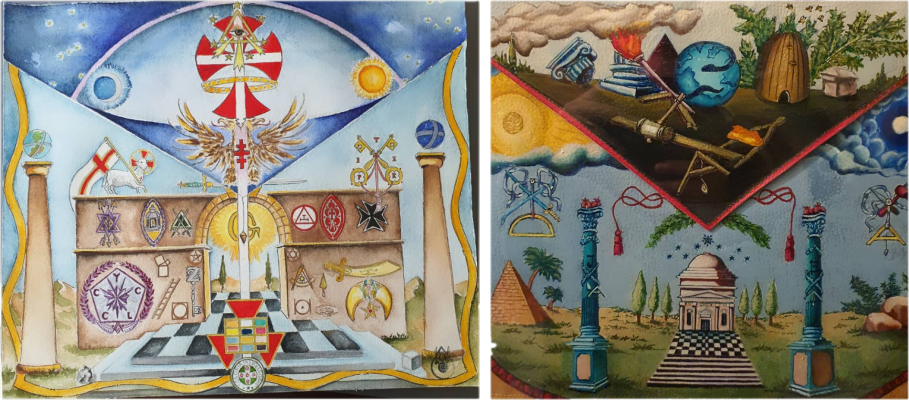
Images (c) copyright Constantinos Biliouris
Web Site: https://constantinosbiliouris.gr/
Instgaram: https://instagram.com/constantinos_biliouris
Recent Articles: Masonic Art series
 Experience the power of Masonic art like never before with our handpicked selection of NFT collections now available on Opensea. Discover stunning works of art from talented artists across the world, all inspired by the ancient traditions and symbols of the Freemasonry. Don't miss out on the chance to own a piece of history - start exploring our Masonic art NFT projects today! |
 Digital Freemasonry NFT Marketplace Unlock the digital realm of Freemasonry with our exclusive NFT marketplace, designed for the modern-day Masonic community. Become one of 333 founders of Digital Freemasonry and gain access to a range of cutting-edge digital tools for the craft. Own a unique NFT as confirmation of your contribution to this ground-breaking initiative. Join us in shaping the future of Freemasonry - start exploring our NFT marketplace now! |
 Experience the legacy of Tubal Cain like never before with our unique collection of Masonic apron NFTs. Each of the 1,000 digital designs are one-of-a-kind and serve as a symbol of Masonic pride and tradition. And for those who prefer to have a physical item, these designs are also available as collectible aprons. Don't miss out on this rare opportunity to own a piece of Masonic history - start exploring our Tubal Cain Masonic apron NFTs now! |
 Discover the transcendent power of music through the eyes of John Philip Sousa. In a world where beauty intertwines with divine inspiration, music becomes a celestial language. Sousa's belief in melodies born from higher realms challenges us to seek the profound, divine connection in our creative expressions. Let music elevate your soul. |
 In a world brimming with wonder, pain, and confusion, the concept of love transcends all boundaries. In this thought-provoking poem, the poet dives into the depths of existence, questioning the nature of love, its transformative power, and the eternal quest to understand its true essence. Prepare to explore the enigma of love, as this poem delves into its many dimensions. |
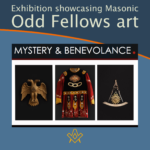 Exhibition showcasing Masonic, Odd Fellows art Art and education in the Hoyt’s newest exhibition, "Mystery & Benevolence: Masonic and Odd Fellows Art", explores the art and accessories of two fraternal organizations steeped in symbols and coded systems, from special handles, gestures and passwords to ritualized performances that probably come from the Middle Ages. |
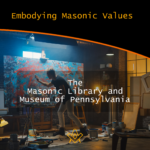 Since 2018, The Masonic Library and Museum of Pennsylvania’s “Embodying Masonic Values” open art competition has provided an opportunity for participants to explore Masonic values through art. Cash prizes are awarded to winners in five categories: Oil, Three-dimensional, Drawing and Print-making, Water-Based Medium and Digital Imagery. Most artwork is also available for sale. |
 Freemasonry in Popular Culture P4 - TV Part 4 of our series on Freemasonry in Popular Culture takes a look at some of the TV series that feature Freemasonry. With much intrigue into the supposed machinations of the Freemasons within business, politics and the police force, TV was a ripe medium for ridicule and sensationalist anti-Masonic propaganda. |
 Freemasonry in Popular Culture P3 - Comic Books and Graphic Novels Part 3 of our series on Freemasonry in Popular Culture takes a look at some of the comic books and graphic novels that feature Freemasonry. |
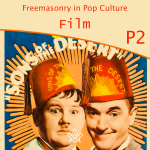 Freemasonry in Popular Culture P2 - Film Following on from Part 1 of Freemasonry in Pop Culture we take a look at Masonic depictions in film. |
 Freemasonry-membership is a mysterious NFT project that would be built across the Metaverse. Taking the idea from virtual lodges, the project is a huge mystery in terms of assets and value for the user. |
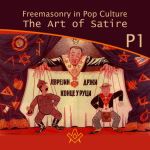 Freemasonry in Popular Culture P1 - The Art of Satire Freemasonry has been the subject of satire and lampooning since its inception in the 1700s courtesy |
 First Three Degrees of Freemasonry by Grant Wood For many of us, the name of the artist Grant Wood doesn’t ring any bells. But on a recent visit to the Grand Lodge of Iowa Masonic Library and Museums, I discovered a hidden gem – Grant Wood's vision of 'The First Three Degrees of Freemasonry'. |
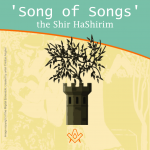 'Song of Songs' - the Shir HaShirim Freemason, composer and artistic director Laurențiu Ganea announces the premiere of his long-awaited composition of the 'Song of Songs' - the Shir HaShirim (also known as the 'Song of Solomon'). |
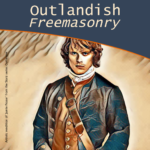 Martin Bogardus explores the Masonic characters and symbolism within the hugely successful 'Outlander' books and TV series. |
 The Masonic Art of Ari Roussimoff The Art, Masonic Aprons, and Magic of Ari Roussimoff - interviewed by Elena Llamas |
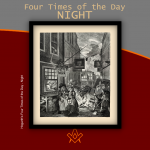 Hogarth's mockery of Freemasonry. A humorous depictions of life in the streets of London, the vagaries of fashion, and the interactions between the rich and poor. |
 This entertaining and infectious poem was written by an Ayeshire poet |
masonic knowledge
to be a better citizen of the world
share the square with two brothers

click image to open email app on mobile device


